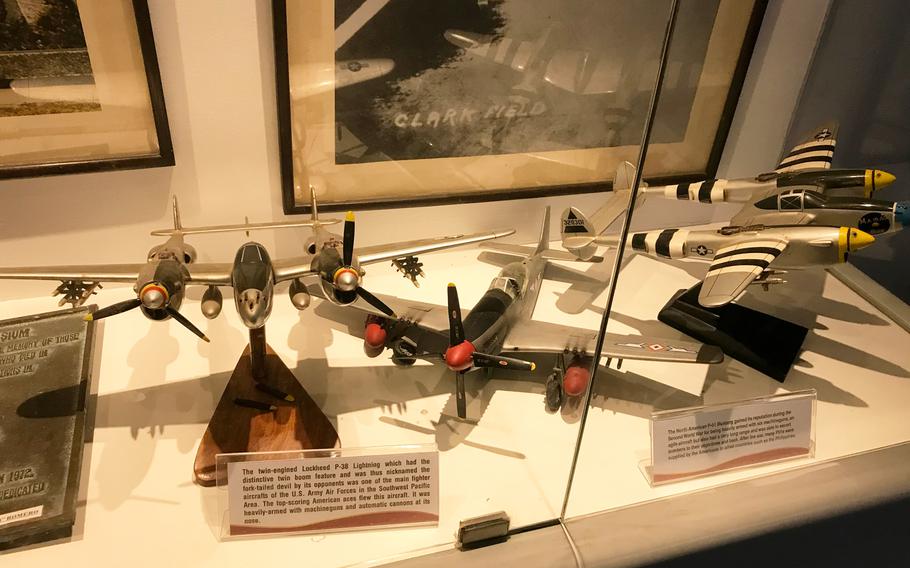
The Clark Museum has dozens of plastic models of planes that flew at the former Clark Air Force Base, ranging from biplanes to combat jets and massive transport aircraft from the 1980s. (Seth Robson/Stars and Stripes)
It wasn’t so long ago that Clark Air Base, America’s then-largest overseas military facility located about two hours north of Manila in the Philippines, was a hive of activity with jets soaring overhead, kids laughing on school playgrounds and shoppers browsing the aisles at the base exchange.
All that’s been history since the eruption of Mount Pinatubo and the departure of U.S. forces in 1991 — but, if you want to take a nostalgic trip to that bygone era, the Clark Museum in Mabalacat City offers just that.
Located in a 1980s-era building that formerly housed the headquarters of the 3rd Combat Support Group, 13th Air Force, the museum has a ground floor devoted to the geology, pre-history and indigenous people of the area where the 160,000-acre base was eventually built.
Upstairs, visitors can learn about the first American soldiers at Clark, which was originally called Fort Stotsenburg, who arrived in the area to battle rebels during the Philippine Insurrection in 1902.
Items on display include an old rail car used at the base, a blue American soldier’s uniform from the era and various other bits of old equipment.
In 1919, threatened by Japanese expansionism, America built an airstrip at the installation — which was then renamed Clark Field after Maj. Harold Clark, an Army aviator killed in a plane crash at the Panama Canal.
The U.S. 3rd Pursuit Squadron operated at Clark Field from 1921 to 1938, according to the museum.
Old photographs show some of those early aviators — and there are also dozens of plastic models of planes that flew at Clark, ranging from biplanes to combat jets and massive transport aircraft from the 1980s.
In December 1941, the Japanese attacked Clark and other U.S. bases in the Philippines before eventually capturing the facility after the Americans evacuated to the Bataan Peninsula.
Photographs and illustrations of Japanese kamikaze pilots who flew from the Philippines during the war are among the museum’s ephemera from this era. Weapons, uniforms and various other bits of gear used by the Japanese Imperial Army are also part of the exhibits.
Mannequins sporting aviator sunglasses represent the U.S. airmen who served at Clark for decades after the war.
An exhibit on the eruption of Mount Pinatubo includes a display of the front pages of Stars and Stripes from Saturday, June 22, and Monday, June 24, 1991. The pages contain reports of the disaster, as well as photographs of ash-covered cars on the base and evacuating Guam-bound personnel. The museum’s theater also offers showings of a short documentary about the event, complete with interactive effects such as wind and mist to simulate a volcanic eruption.
These days, most of the old American buildings and facilities at Clark remain — although the runway is now a commercial airport, and the towns surrounding the former base are growing rapidly.
Many of the airmen who served at Clark never left the Philippines — and the local American expatriate population in the immediate area is estimated to be in the thousands. The Clark Museum serves as a tangible reminder of their glory days.
robson.seth@stripes.com Twitter: @SethRobson1
Clark MuseumDIRECTIONS: The Clark Museum is located on the grounds of the former Clark Air Base in Mabalacat City in Pampanga province. The museum is next to the old base sports fields, a few hundred meters’ walk from the Quest Hotel — which was once on-base lodging.
TIMES: Tuesday through Sunday, 9 a.m. to 4 p.m.
COSTS: Admission is 200 pesos (about $3.70) for adults, and free for children and senior citizens.
FOOD: There’s no food for sale at the museum — but numerous restaurants and convenience stores are located nearby.
INFORMATION:www.visitclark.com/museum4d.html